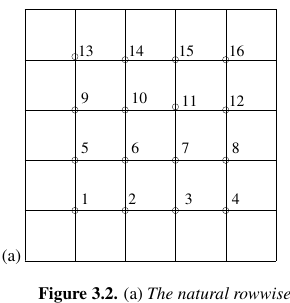If we use 5-point finite difference approximations in a uniform rectangular grid to solve the Poisson PDE
\begin{align} -\Delta u &= f \ \ \text{en} \ \ (0,1)\times (0,1) \label{P1} \\ u &= 0 \ \ \text{en} \ \partial ((0,1)\times (0,1)) \label{P2} \end{align}
The Laplacian operator $\nabla^2$ can be written using the Kronecker product as follows: $$ \nabla^2 = T\otimes I_{n_{x}} + I_{n_{y}} \otimes T $$
where $I_{n}$ is the identity matrix of size $n$ and the matrix $T$ is given by \begin{equation} T = \frac{1}{h^2}\left[\begin{matrix} -2 & 1 & & 0\\ 1 & \ddots & \ddots & \\ & \ddots & \ddots & 1 \\ 0 & & 1 & -2 \end{matrix} \right] \end{equation}
where $h>0$ is the mesh size.
EDIT: The 9-point finite difference approximation has the following stencil:
If we consider the natural rowwise order
see the book by Randall J. LeVeque - Finite Difference Methods for Ordinary and Partial Differential Equations: Steady-State and Time-Dependent Problems.
It can shown that the 9-point approximations leads to
\begin{equation} \nabla^2 = \frac{1}{6h^2}\left[\begin{matrix} D_{1} & D_{2} & & 0\\ D_{2} & \ddots & \ddots & \\ & \ddots & \ddots & D_{2} \\ 0 & & D_{2} & D_{1} \end{matrix} \right] \end{equation}
where
\begin{equation} D_{1} = \left[\begin{matrix} -20 & 4 & & 0\\ 4 & \ddots & \ddots & \\ & \ddots & \ddots & 4 \\ 0 & & 4 & -20 \end{matrix} \right] \end{equation}
and
\begin{equation} D_{2} = \left[\begin{matrix} 4 & 1 & & 0\\ 1 & \ddots & \ddots & \\ & \ddots & \ddots & 1 \\ 0 & & 1 & 4 \end{matrix} \right] \end{equation}
Now consider the matrices
\begin{equation} K = \frac{1}{6h^2}\left[\begin{matrix} 10 & 1 & & 0\\ 1 & \ddots & \ddots & \\ & \ddots & \ddots & 1 \\ 0 & & 1 & 10 \end{matrix} \right] \end{equation}
\begin{equation} I_{R} = \left[\begin{matrix} -2 & 2/5 & & 0\\ 2/5 & \ddots & \ddots & \\ & \ddots & \ddots & 2/5 \\ 0 & & 2/5 & -2 \end{matrix} \right] \end{equation}
\begin{equation} I_{L} = \left[\begin{matrix} 0 & 3/5 & & 0\\ 3/5 & \ddots & \ddots & \\ & \ddots & \ddots & 3/5 \\ 0 & & 3/5 & 0 \end{matrix} \right] \end{equation}
A quick computation shows that
\begin{equation} K \otimes I_{R} + I_{L} \otimes K = \frac{1}{6h^2}\left[\begin{matrix} D_{1} & D_{2} & & 0\\ D_{2} & \ddots & \ddots & \\ & \ddots & \ddots & D_{2} \\ 0 & & D_{2} & D_{1} \end{matrix} \right] \end{equation}
Questions:
- Do you know tensor product representations for the 9-point finite difference approximations for the $\nabla^2$ operator?
- Do you know books or articles where I can study tensor product representations for the 9-point or higher order finite difference approximations for the $\nabla^2$ operator?
- Do you know books or articles where I can study implementation details for the Poisson equation in 2D?
New questions:
- Is this a valid tensor representation for the 9-point Laplacian operator or do you know other representation for this operator?
- Is there a general way to deduce a tensor representation for high-order finite difference approximations for the Laplacian operator?
Thanks in advance.

